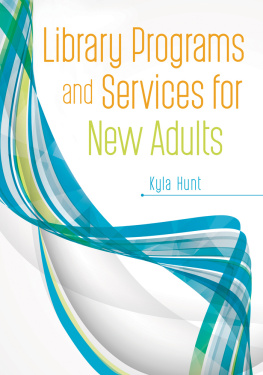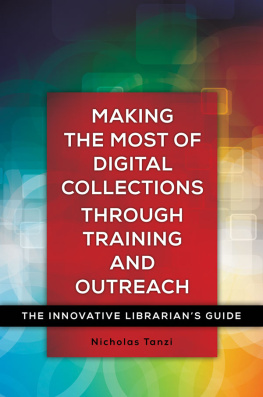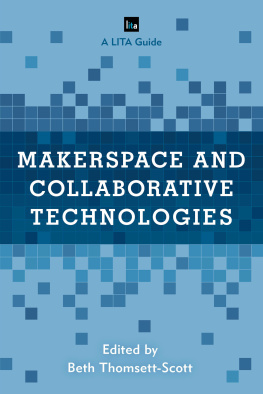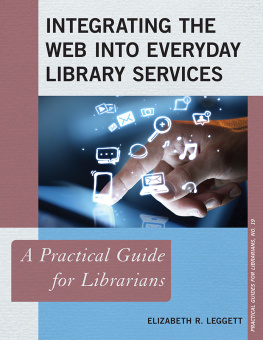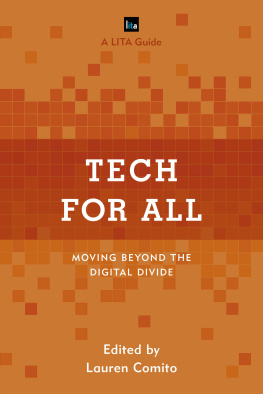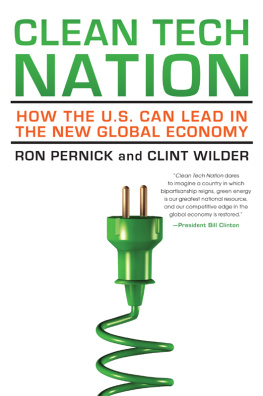Raising the Tech Bar at
Your Library
RAISING THE TECH
BAR AT YOUR
LIBRARY
Improving Services to
Meet User Needs

Nick D. Taylor

Copyright 2017 Nick D. Taylor
All rights reserved. No part of this publication may be reproduced, stored in a retrieval system, or transmitted, in any form or by any means, electronic, mechanical, photocopying, recording, or otherwise, except for the inclusion of brief quotations in a review, without prior permission in writing from the publisher.
Library of Congress Cataloging-in-Publication Data
Names: Taylor, Nick D., author.
Title: Raising the tech bar at your library : improving services to meet user needs / Nick D. Taylor.
Description: Santa Barbara, California : Libraries Unlimited, an imprint of ABC-CLIO, LLC, [2017] | Includes bibliographical references and index.
Identifiers: LCCN 2017018675 (print) | LCCN 2017000171 (ebook) | ISBN 9781440844973 (ebook) | ISBN 9781440844966 (paperback : acid-free paper)
Subjects: LCSH: Public librariesInformation technology. | Libraries and the Internet. | Public services (Libraries) | Technological literacyStudy and teaching. | LibrariansEffect of technological innovations on. | Library usersEffect of technological innovations on. | Public librariesUnited StatesCase studies.
Classification: LCC Z678.9 (print) | LCC Z678.9 .T39 2017 (ebook) | DDC 020.285/4678dc23
LC record available at https://lccn.loc.gov/2017018675
ISBN: 978-1-4408-4496-6
EISBN: 978-1-4408-4497-3
21 20 19 18 17 1 2 3 4 5
This book is also available as an eBook.
Libraries Unlimited
An Imprint of ABC-CLIO, LLC
ABC-CLIO, LLC
130 Cremona Drive, P.O. Box 1911
Santa Barbara, California 93116-1911
www.abc-clio.com
This book is printed on acid-free paper 
Manufactured in the United States of America
To Tracy and Fiction Beer Company for making the
brainstorming sessions highly enjoyable.
To Corvus Coffee Roasters for the caffeine,
Wi-Fi, and seating space!
Contents
Why Raise the Bar?
Introduction
Short History of Tech in Libraries
Whats Happening in Libraries Now?
Why This Is Important
o The Digital Divide
o Makerspaces and STEM
How to Convince Your Community and the People in Charge
Affordable Alternatives
INTRODUCTION
Raising the bar for tech services in libraries means going above and beyond basic technology offerings. Basic offerings are what youre likely to find in nearly 90 percent of libraries: computer classes, public computers, e-books, and Wi-Fi (Clark & Perry, 2015). To further improve public perception of libraries and to advocate for even more meaningful usage of these community institutions, the purpose of this book is to encourage libraries to focus on ways to improve their existing tech services or even to expand their offerings. For example, your library may provide computer classes, but what can you do to make sure the ideas are sticking, that your students are truly learning? You may have grand plans to purchase a 3D printer, but how will you ensure the community wants it, and then how will you convince your superiors its a great idea?
Questions like these inspired this book. Hopefully it will equip you with the tools needed to do whats mentioned above and more. Consider it guidance for the average library and librarian, for those who are looking to expand upon and improve their technology services. It is a practical guide, but is also intended to inspire.
feature more specific subjects like staffing, physical space, and learning. The final chapter reflects on current trends and the future so you can continue to anticipate ways to iterate and improve your tech services.
The author and the colleagues he has consulted while creating this book work for tech departments in libraries that have raised the bar when it comes to tech services. Makerspaces, coding initiatives, unique computer classes, and other complex tech interactions have become the norm in these libraries. As a result, the author draws on his own experiences and those of his colleagues to help inform his opinions. The libraries used for inspiration, Arapahoe Libraries and Denver Public Library, are medium- to large-sized library systems in the metropolitan area of Denver, both of which have implemented sweeping technology services in the form of initiatives, staffing, and programming. But this isnt a local phenomenon; libraries all over the country, and indeed all over the world, are doing innovative things with technology.
First and foremost, advice in this book takes into consideration that iterating and improving upon your technology services should not necessarily have a lot of dollar signs attached. More important is library philosophy, or attitude. The author acknowledges that there are libraries of all sizes and budgets, from single-employee rural libraries to modern, urban, trendsetting libraries, and one size certainly does not fit all. Arapahoe Libraries and Denver Public Library are on the whole more willing to take risks, especially when it comes to budgeting. Although well-allocated money can be a fast track to improving your tech offerings, libraries of all sizes and budgets share a passion for great technology services. With this in mind, the author offers suitable alternatives and mentions where theres room for savings whenever possible. (Consult the Affordable Alternatives sections at the end of for suggestions.)
SHORT HISTORY OF TECH IN LIBRARIES
To understand why tech services in libraries are important and why you should be passionate about improving on them even further, a short history of tech in libraries is in order. Once you see how libraries have evolved into tech-forward spaces full of tablets, 3D printers, and makerspaces, you will have a much better idea of how you and your library can move forward.
By far the most influential technological innovation for libraries in recent memory is the Internet. Libraries were one of the first public institutions to fully harness it. Long before Internet access was as ubiquitous as it is today, libraries offered public computers with access to this burgeoning technology. Though Internet access had been adopted and used in libraries earlier, expansion truly began in the mid- to late 1990s. In the short span between 1994 and 2002, the percentage of public libraries connected to the Internet grew from 21 to nearly 100 percent (Bertot, Jaeger, Wahl, & Sigler, 2011). These numbers show that libraries quickly recognized the need for Internet access and rapidly adapted to offer the service to their users.
As a result, libraries began to add more computers for public access and computer labs. Information retrieval in libraries was more important than ever, but now the tools were increasingly in the hands of the patrons rather than only accessible through a librarian at a reference desk. This change in the way the average person accessed information ushered in the information age, the era in which Internet access has become common and ubiquitous, when information seekers turn to the Internet and digitized information for their needs more frequently than to physical media such as encyclopedias and periodicals. Herrera-Viedma and Lopez-Gijon (2013) observed that libraries and librarians have in some ways been replaced by, respectively, the Internet and Google. They are not the only ones to think this. In fact, many people, including some politicians and public officials, hold the mistaken view that there is no need for libraries now that we have the Internet. The Internet serves as the repository of information that the traditional library was; the search engine retrieves said information. Since physical media used to be the average librarys primary focus, this has signified a significant shift. Herrera-Viedma and Lopez-Gijons suggestion is for the library to forget about being an information repository and instead work toward building great relationships with library users through providing an educational community institution, a community gathering place for a meeting of the minds. Library philosophy has remained the same in the information age; libraries continue to provide access to resources and information, just through different media. This information cannot be held in your hands the way a reference book or printed government document could be, but libraries provide just as much (if not more) meaningful information and context today as they have in the past. Yet despite the similarities in what the end user ultimately receives, the information age has changed the roles of modern-day librarians and the needs that their communities prioritize.
Next page


